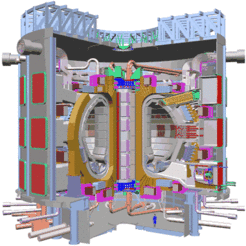Engineers for ITER – trained at IPP in Garching and Greifswald
Training programme of the European Union / specialists in fusion research

In the "Superconducting Magnets" training programme at the Greifswald branch of IPP four young engineers are following the production of the 70 large superconducting magnets for the Wendelstein 7-X fusion experiment in order to gain an insight into how research and industry collaborate. With a "cold mass" of 450 tonnes cooled to superconduction temperature close to absolute zero, Wendelstein 7-X features the largest cryo system at present in European fusion research – thus providing an ideal training ground for future ITER engineers. In the European network, headed by Dr. Thilo Scholz and comprising three research institutions and three industrial companies, the young engineers are gaining experience, from industrial production of superconducting magnets and the appropriate cryogenic technology via quality management and control to installation in the experimental device.
At IPP in Garching the "Radio-frequency Heating" training programme, headed by Prof. Jean-Marie Noterdaeme, supplies know-how on the heating of a fusion plasma with radio-frequency waves. The appropriate practical training is partly provided at Garching’s ASDEX Upgrade fusion device. In conjunction with six other research institutions and a partner from industry six young engineers in the network are to acquire the expertise required for developing and producing high-tech components for radio-frequency heating of ITER. They will thus be equipped to cope with the huge high-frequency power needed in ITER – 20 megawatts envisaged. Three more engineers are being trained at Garching in the "Materials Research" programme and at Greifswald in the "Diagnostics" programme.
The aim of fusion research is to develop a power plant that, like the sun, derives energy from fusion of atomic nuclei. To ignite the fusion fire, it is necessary to confine the fuel, a hydrogen plasma, in magnetic fields and heat it to temperatures of 100 million degrees. The next major step is the ITER international fusion test reactor, construction of which will be started in 2008 at Cadarache, France, in an international cooperation.
Isabella Milch
